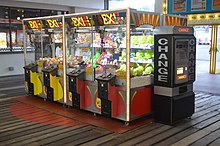Claw crane
A claw crane, claw machine, toy crane or skill crane is a type of arcade game known as a merchandiser, commonly found in video arcades, supermarkets, restaurants, movie theaters, shopping malls, and bowling alleys.[1]

Machine components
A claw crane consists of many parts, but the basic components are a printed circuit board (PCB), power supply, currency detector, credit/timer display, joystick, wiring harness, bridge assembly, and claw. The claw has two or more fingers, although most claws have three.[2]
The cabinet is usually constructed of medium-density fiberboard (MDF). Some cabinets are made of aluminum alloy, which makes it easier to relocate as well as cheaper to produce.
The window at the front of the machine is normally made of glass or a cheaper-to-manufacture substitute, such as acrylic. The marquee is a branded graphic (sometimes created specifically for restaurants or an operator's business name) behind a Plexiglass front.
Some claw cranes (mainly in the UK) use Foam Peanuts for sitting the prizes on top of the machine or to raise or lower the prizes with a cloth on top of them.
Gameplay

A claw vending machine consists of prizes, usually plush toys or alternatives such as jewelry, capsuled toys, hats, balls, dolls, shirts, candy and devices. More expensive prizes are sometimes placed in a plastic bag so the toy is harder to pick up. The player inserts money or tokens into the machine, which then allows the player to manipulate a joystick that controls the claw for a variable amount of time, (controlled by the operator) usually 30 seconds, and rarely, even a minute. The player is able to move the claw back, forth, and sideways. Some machines allow the user to move the claw after it has partially descended.
At the end of the playtime (or earlier if the player presses a trigger button on the joystick), the claw descends and makes an attempt to grip. After making the gripping attempt, the claw then moves over an opening in the corner of the case and releases its contents. If the player is successful, then the prize the claw is holding is dropped into the opening and dispensed through a chute into a hatch for collection.
An alternative version of the machine, popular in arcades, is the two button version: one marked with a forward arrow, one with a right arrow. The crane starts near the front, left side of the machine and the user presses first the forward button to move the crane towards the back of the cabinet. Once the button is released the crane stops moving and the button cannot be used again, thus requiring the user to judge depth accurately in one attempt. After this, the right button becomes active in a similar way and as soon as it is released, the crane drops to a certain depth and then raises, closing its claw on the way and returning to the drop hatch in the front left corner. These versions are generally considered to be more difficult. The button type machines typically do not feature the timers which are commonly found on joystick type machines.
Machine configuration and chances of winning
The success rate of winning a prize is dependent on several factors including operator settings, player skill, type of machine, and the prizes available (size, density, and distribution). A prize may be lost due to player inexperience, player error in manipulating the claw, the weakness of the claw, or the specific crane configuration. Many modern cranes use a computer to determine an expected payout percentage based on the operator's settings. All modern claw machines incorporate some means for the owner to adjust at least the strength of the claw's grip and how closely the claw's fingers pull together, usually with screws on the mechanism or potentiometers on the PCB. Even on older machines, the grip strength can be adjusted by adding circuit components or additional hardware.[3] Some machines incorporate a feature called two-level claw power, which, when enabled, causes the claw to at first grip at full strength, but then gradually weaken its grip to the normal level after a brief delay. This can cause the crane to initially pick up the prize, but then drop it.[4]
Modern claw machines are fully computerized and are remotely programmable by the owner (via a hand-held device). Settings and features commonly available include:[5]
- Claw strength and aperture
- Motion speed, in any direction (for example, the claw can be made to drop slowly but come up quickly, or move right faster than it moves forward)
- Pick-up strength and retain strength can be specified separately, as well as the delay between pick-up and return.
- Payout percentage: Cranes equipped with this setting have onboard programming which causes the claw's grip parameters to be continually adjusted to achieve a pre-set payout percentage, usually specified with respect to the value of the prizes inside
- Fail limit: If the machine dispenses too many prizes in a given time period, it stops accepting coins and is out of order
- Free replay can be granted on a certain percentage of plays
- Instant replay: the user can opt to touch a certain button and have the claw automatically move to where it was last dropped, in order to try again for a prize that was just missed on the previous try.
Some cranes are also able to display the number and value of prizes won in a given time period,[5] enabling the owner to keep track of how profitable the machine is for them.
Claw machines holding expensive prizes, such as a video game console or a mobile phone are typically programmed so that the grip strength of the claw is determined according to a payout percentage that is profitable to the operator. Experienced skill crane players also say that box shaped prizes are among the most difficult kinds of objects to pick up with any claw, regardless of its settings.
Legality
The ability of the crane machine owner to set features such as a payout percentage raises the question of whether these machines should be considered gambling devices in a legal sense, alongside slot machines. In the United States, claw vending machines are typically specifically exempted from statutes which regulate gambling devices, contingent upon compliance with certain rules. In the state of Michigan, for example, this exemption applies only if the wholesale value of the prizes inside is below a certain threshold, and if these prizes are actually retrievable with the claw.[6] Other states regulate crane machines very little. In addition, some attorneys have advised claw machine owners to avoid using the word "skill" in the game description decal present on most machines.[7]
In other jurisdictions, such as Alberta, Canada, skill cranes are illegal unless the player is allowed to make repeated attempts (on a single credit) until he or she succeeds in winning a prize.[8] Skill cranes in single-play mode (where the player has only one chance per credit to try for a prize) were found by the Ontario Court of Appeal to be essentially games of chance, and therefore prohibited except at fairs or exhibitions, where they are covered by an exemption.[9]
Global popularity
Asia
Claw cranes became popular in Asia, in particular, Japan (where they are known as UFO catchers), Korea and Taiwan, from 1990s onwards.[10]
United States
In the early 20th century, popular photographs of the excavation of the Panama Canal made the steam shovel into an object of popular fascination. This trend inspired novelty candy dispensers made to look like steam shovels. Players would put a nickel into the slot of a glass-fronted cabinet and crank a wheel to engage a series of internal gears. The tiny bucket-jaws swung down, closed over a piece of candy, rose, and dropped the sweet into a chute where it could be retrieved. Early versions of these games include the Panama Digger, Erie Digger, and Iron Claw. The most successful model was the Miami Digger patented by carnival operator William Bartlett in 1932. The prizes were silver dollars or rolls of coins, and Bartlett operated the machines himself rather than selling them.[11] Over the decades, the mechanics and aesthetics of these candy dispensers evolved into the modern claw games of today.[12]
A claw machine labeled "Toy Steam Shovel" appears in a drugstore in the cartoon Naughty but Mice (1939) featuring Sniffles the Mouse.
In Davis Grubb's 1971 novel, The Barefoot Man, set in 1930 in West Virginia, Jack Farjeon wants to get a gun in secret and is challenged to retrieve one from a crane game, at a price of $10 a play, with the first play free. He gets the gun after seven tries.
These machines became popular in the United States in the late 1980s, with a significant presence at Pizza Hut restaurants, although they were to be found much earlier. Later on, the machines spread to other venues, and by the early 1990s, the NFL began to advertise their teams with stuffed footballs of each team placed in some of the machines. Soon after, the MLB, NBA, and NHL also started doing this, although the NBA no longer uses these machines as a means of advertisement.
By the mid-1990s, the machines' popularity had made such establishments as Safeway, Fry's Supermarkets, K-Mart, and Wal-Mart a staple of their locations. Some hotels also acquired them to satisfy their younger guests, as did sports venues that would stuff them with collectibles related to their home teams.
In the 1995 Disney/Pixar computer-animated film Toy Story, Buzz Lightyear and Sheriff Woody climb into a claw vending machine filled with claw-worshipping aliens.
In the SpongeBob SquarePants season 4 episode "Skill Crane", Mr. Krabs introduces the skill crane machine to SpongeBob and Squidward in the Krusty Krab.
References
- Jeff Travilla (2017-12-22), Evil Claw Machine - The Dumbest Dumb Machine, retrieved 2017-12-23
- DiMatteo, Nick. "LinkedIn Profile for Nick DiMatteo". LinkedIn. Retrieved November 7, 2019.
- "Universal Crane Replacement Logic Board manual" (PDF). Archived from the original (PDF) on 2008-10-06. Retrieved 2008-07-02.
- "SUNRISE UPGRADE KIT for LAI "SkillTester"". Retrieved 2008-07-02.
- Cromptons Inc (2003). X-Factor Crane Owner's and Service Manual (PDF). Archived from the original on 2015-04-19.CS1 maint: BOT: original-url status unknown (link)
- "Michigan Gambling Law". Retrieved 2008-07-02.
- Snyder, Bob. "Skill Crane Operators Can Defend Against 'Unfair Practices' Lawsuits". Archived from the original on 2009-05-11. Retrieved 2008-07-04.
- "Mere 'dash of skill' makes crane game illegal: court". National Post. January 29, 2002. p. A1, 10. Archived from the original on August 10, 2007. Retrieved July 10, 2008.
- Lipton, Michael D.; Lazarus, Morden C.; Weber, Kevin J. (2005). "Games of Skill and Chance in Canada". Gaming Law Review. 9: 10–18. doi:10.1089/glr.2005.9.10.
- Yoon, Dasl (September 29, 2017). "Grasping for Hope. Claw arcades – and youth unemployment – swell in South Korea".
- Rossen, Jake. "Dime After Dime: A Gripping History of Claw Machines". Mental Floss. Retrieved 10 July 2016.
- Eldredge, Barbara. "Cult of the Claw".
External links
| Wikimedia Commons has media related to Claw crane. |